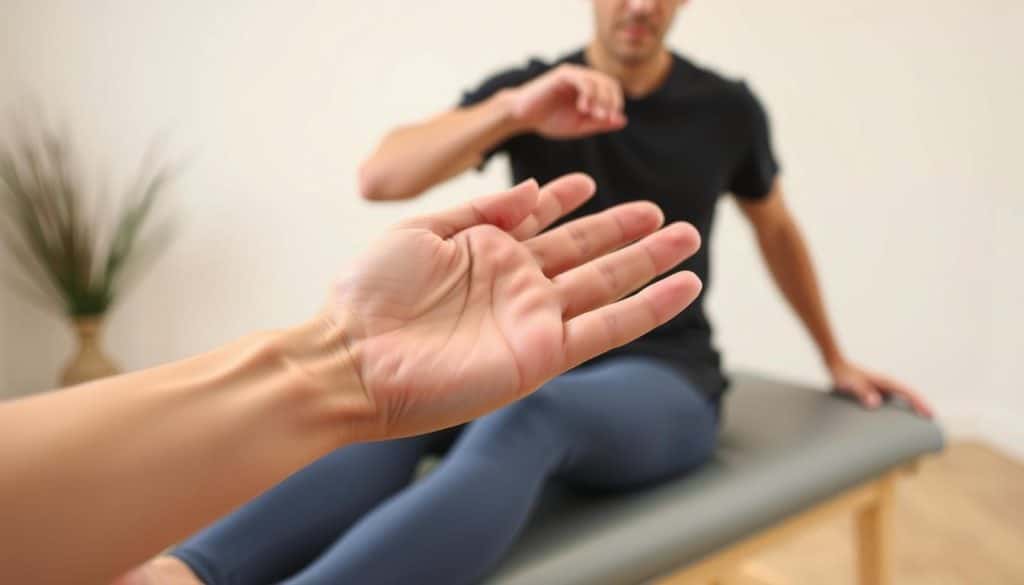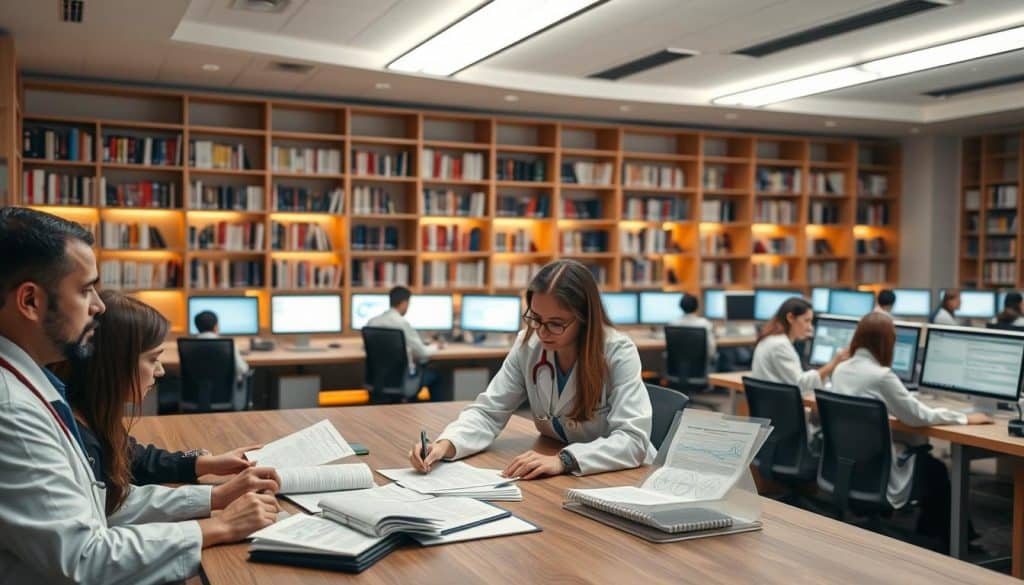1 in 5 Canadian adults experiences nerve-related pain that limits daily activities. At Riverside Sports Therapy in Calgary, we’ve seen how targeted manual therapy techniques can transform recovery outcomes. But not all approaches work the same for every person.
Your nervous system acts like an electrical network, with nerves needing smooth movement through muscles and joints. When injuries or inflammation restrict this mobility, pain and stiffness often follow. Research confirms specialized techniques can improve nerve function by addressing these restrictions.
Two methods stand out in clinical practice. One gently glides nerves through their pathways. The other creates controlled tension to promote adaptability. Both aim to reduce discomfort, but their effects on your body differ significantly.
Key Takeaways
- Nerve mobility techniques improve mechanical function and reduce pain
- Individual factors like injury severity determine which method works best
- Both approaches influence sympathetic nervous system activity
- Treatment effectiveness depends on your unique health status
- Clinical evidence supports tailored application for optimal results
We’ll break down how these therapies interact with your nervous system. You’ll learn why your recovery timeline, pain patterns, and tissue health guide our treatment decisions. Let’s explore what science says about choosing the right approach for lasting relief.
Introduction to Neurodynamic Techniques
Effective nerve function relies on smooth movement through joints and tissues. When restrictions occur, specialized methods can restore optimal performance. These approaches focus on your body’s natural wiring without forceful adjustments.
Understanding Neural Mobilization
Your nervous system acts like highways for electrical signals. Neural mobilization helps address tight spots where nerves pass through muscles or bones. Therapists use precise movements to improve sliding capacity while monitoring your responses.
Three key benefits make this approach effective:
- Reduces mechanical stress on irritated pathways
- Enhances nutrient delivery to nerve tissues
- Improves communication between body areas
Historical Development and Modern Practice
Early studies in the 1980s revealed how nerves move during daily activities. This research shaped today’s methods used at our Calgary clinic. We combine anatomical knowledge with real-time feedback during sessions.
Modern protocols prioritize safety through:
- Detailed movement assessments
- Gradual progression models
- Continuous symptom monitoring
Current techniques evolved from decades of clinical trials and biomechanical analysis. Your treatment plan reflects both historical wisdom and cutting-edge science.
The Role of Neural Mobilization in Pain Management
Persistent discomfort often stems from restricted neural pathways that need targeted care. At Riverside Sports Therapy, we prioritize restoring your nerve mobility through evidence-based strategies. This approach addresses both mechanical limitations and your body’s pain signaling systems.

Nerve Gliding Explained
Gliding techniques gently encourage natural nerve movement through surrounding tissues. Imagine easing a rope through a narrow sleeve – this method reduces friction that triggers pain signals. Benefits include:
- Improved tolerance to stretching during daily motions
- Reduced pressure on sensitive neural structures
- Enhanced blood flow to irritated areas
Our Calgary therapists assess your movement patterns first. We then guide you through customized exercises that promote smooth neural motion without overstressing tissues.
Tension Mechanisms Explained
Tension-based methods work differently by creating controlled stress on restricted pathways. This stimulates your nervous system to adapt and build resilience. Key effects involve:
- Breaking cycle of protective muscle guarding
- Encouraging nerve elongation capacity
- Modulating pain perception thresholds
We monitor responses closely to ensure gradual progress. Whether treating neuropathic pain or movement restrictions, your treatment plan balances these complementary approaches.
Clinical Evidence and Local Guidelines in Calgary
Calgary’s healthcare community relies on rigorous scientific studies to shape treatment protocols. At Riverside Sports Therapy, we base our methods on findings from randomized controlled trials that meet Alberta Health Services standards. A landmark study with 90 participants revealed how specific techniques influence your body’s stress responses, even in healthy individuals.

Recent research shows these approaches activate your sympathetic nervous system differently than traditional therapies. This explains why some patients report immediate changes in mobility after treatment. Our team analyzes peer-reviewed data to ensure every session aligns with current evidence.
Three key factors guide our practice:
- Adherence to Calgary’s clinical guidelines for manual therapies
- Integration of randomized controlled trial outcomes
- Regular updates from systematic review publications
While studies confirm positive effects on nerve function, gaps remain in long-term research. We prioritize techniques with strong support in Canadian health literature. Your care plan combines proven methods with personalized adjustments based on real-time feedback.
Local regulations require therapists to use approaches backed by quality research. This protects your health while ensuring measurable recovery progress. We continuously evaluate new findings to maintain our clinic’s gold-standard reputation in nerve-related care.
neurodynamic sliders vs tensioners
Your recovery journey requires understanding how different methods affect nerve pathways. Two distinct approaches exist for improving neural mobility, each creating unique effects on your body’s wiring system.
Slider methods coordinate directional movements at both ends of a nerve pathway. This synchronization reduces overall strain while encouraging smooth gliding through tissues. Research shows these gentle motions work well when inflammation or recent surgery makes nerves extra sensitive.
Tensioner approaches apply opposing forces simultaneously. This creates controlled stress along the entire nerve length, challenging restricted areas to adapt. Studies indicate this method proves more effective for long-standing issues where tissues require stronger stimulation to change.
Three key factors determine which strategy we recommend:
- Current pain intensity during daily activities
- Time elapsed since initial injury or symptom onset
- Your body’s response during hands-on assessment
Acute injuries often respond better to slider techniques that minimize mechanical stress. Chronic conditions may need tensioner applications to break persistent stiffness patterns. Our Calgary therapists combine movement analysis with real-time feedback to choose your optimal path forward.
Biomechanical Benefits of Neurodynamic Sliders
Coordinated joint movements play a crucial role in nerve mobilization. Slider techniques balance elongation and shortening across nerve pathways, creating smooth gliding motions. This approach reduces mechanical stress while improving tissue mobility.
- Minimize tissue strain through synchronized joint actions
- Enhance nutrient distribution along neural pathways
- Promote pain-free movement patterns gradually
Large-amplitude slider movements help retrain your brain’s pain responses. The rhythmic nature decreases sensitivity to motion triggers. Many patients report improved comfort during daily activities after consistent practice.
Slider approaches accelerate tissue recovery by avoiding aggressive stretching. This makes them ideal for recent injuries or sensitive conditions. Therapists often combine these techniques with other interventions for comprehensive care plans.
Physiological Impact of Neurodynamic Tensioners
Controlled stress on neural pathways triggers adaptive mechanisms essential for recovery. Tensioner techniques create measurable changes in your body’s internal environment through precise mechanical loading. These approaches stimulate your nervous system to improve self-regulation and tissue resilience.
The pumping action generated during tensioner application reduces pressure buildup within nerve fibers. This enhances circulation to compressed areas, delivering oxygen and nutrients critical for healing. Studies show improved nerve perfusion lasts up to 48 hours post-treatment in some cases.
Your sympathetic nervous system responds distinctly to these methods. Research reveals increased skin conductance and heart rate variability during sessions, indicating heightened autonomic engagement. These effects may explain why tensioners often produce faster pain modulation than gentler approaches.
Three key physiological adaptations occur with proper tensioner use:
- Enhanced nerve glide capacity through restrictive tissues
- Reduced inflammatory markers around compromised pathways
- Improved tolerance to mechanical stressors over time
Body-wide responses like localized temperature changes demonstrate the systemic nature of these techniques. At Riverside Sports Therapy, we monitor these reactions to ensure your treatment progresses safely toward lasting functional improvements.
Practical Applications at Riverside Sports Therapy
Our Calgary clinic tailors every session to your unique recovery needs. We combine research-backed methods with real-time feedback to optimize treatment outcomes. Your care begins with detailed assessments that map nerve mobility patterns and identify movement restrictions.
Standardized protocols guide our approach while allowing flexibility. For example, therapy sessions might include timed movement sequences with precise rest intervals shown to improve results. Research-based parameters ensure consistency while accommodating your body’s responses.
Three key elements define our physical therapy applications:
- Custom exercise durations matching clinical trial evidence
- Gradual intensity adjustments based on symptom changes
- Integrated monitoring of autonomic responses like pulse and sweating
Patients receive techniques adapted to their specific conditions and treatment goals. If you’re recovering from acute injuries, therapists might use shorter movement cycles. Chronic issues often require progressive loading to rebuild tissue tolerance.
Our team completes advanced training in therapeutic application safety measures. You’ll experience controlled movements that respect your current capabilities while encouraging gradual improvement. Regular progress evaluations ensure your plan evolves as you heal.
Mechanisms Behind Nerve Gliding and Tensioning
Your body’s wiring system responds uniquely to different therapeutic pressures. Cadaver studies reveal how controlled movements influence nerve health through fluid dynamics and circulation changes. These findings shape modern approaches to restoring neural function.
How Sliders Enhance Nerve Movement
Coordinated joint motions create a pumping action along neural pathways. This synchronized movement disperses fluids within nerve tissues, reducing swelling that causes discomfort. Research shows improved circulation helps nutrients reach compressed areas more effectively.
Three key processes occur during slider techniques:
- Gentle pressure gradients move stagnant fluids through restricted zones
- Rhythmic motions prevent excessive stretching of sensitive tissues
- Nerve pathways regain natural sliding capacity through repetition
How Tensioners Affect Nerve Excursion
Controlled loading stimulates your nerves to adapt their movement patterns. This approach increases mechanical stress gradually, encouraging tissues to build tolerance. Studies indicate tensioner methods boost axoplasmic flow – the vital nutrient transport system within nerve fibers.
Your treatment benefits from these physiological changes:
- Enhanced nerve conduction speeds through compressed regions
- Reduced protective muscle spasms around irritated pathways
- Improved tissue healing responses from optimized circulation
At Riverside Sports Therapy, we monitor how your system responds to these interventions. Real-time feedback guides adjustments for maximum effectiveness and safety during recovery.
Considerations for Technique Selection and Patient Safety
Your safety drives every decision at Riverside Sports Therapy. Our Calgary team follows strict protocols to match techniques with your specific needs. Personalized care begins with understanding your health history and current symptoms.
Assessment Guidelines
Studies show 38% of individuals with neck or low back pain require modified approaches. We exclude techniques for patients with active inflammation, diabetes, or recent surgeries. Your assessment includes checking skin sensitivity, movement patterns, and pain triggers.
Research confirms nerve gliding isn’t safe for everyone. Our therapists screen for conditions like complex regional pain syndrome before treatment. Position testing reveals how your body responds to different movement angles.
Safe Practice Protocols
Proper positioning protects your neck and low back during sessions. Therapists adjust techniques if you report increased pain or tingling. We follow study-backed methods that prioritize gradual progress over aggressive interventions.
Individuals recovering from injuries receive modified plans focusing on gentle motion. Your treatment adapts weekly based on feedback and functional goals. This approach minimizes risks while maximizing your recovery potential.
